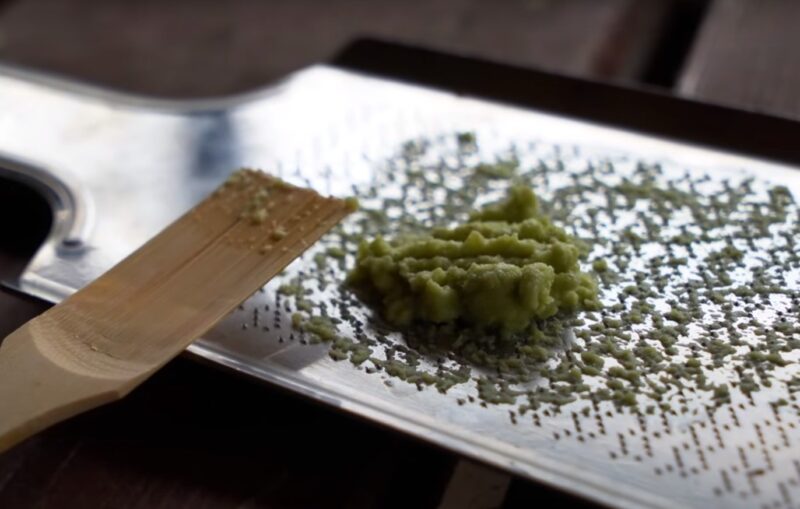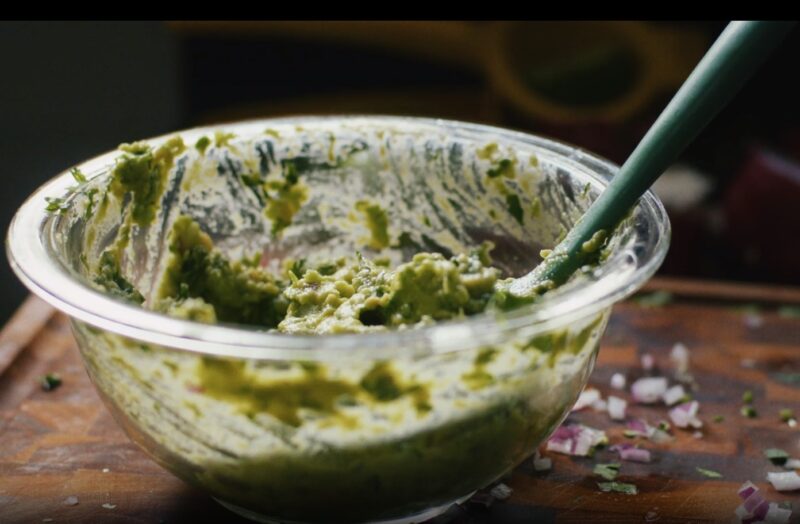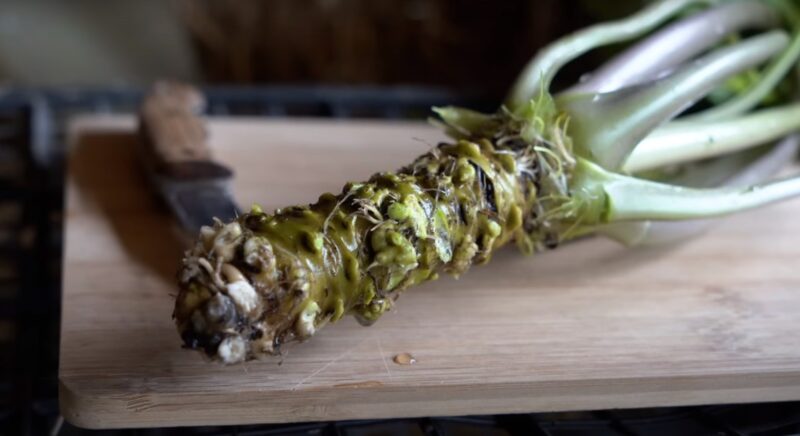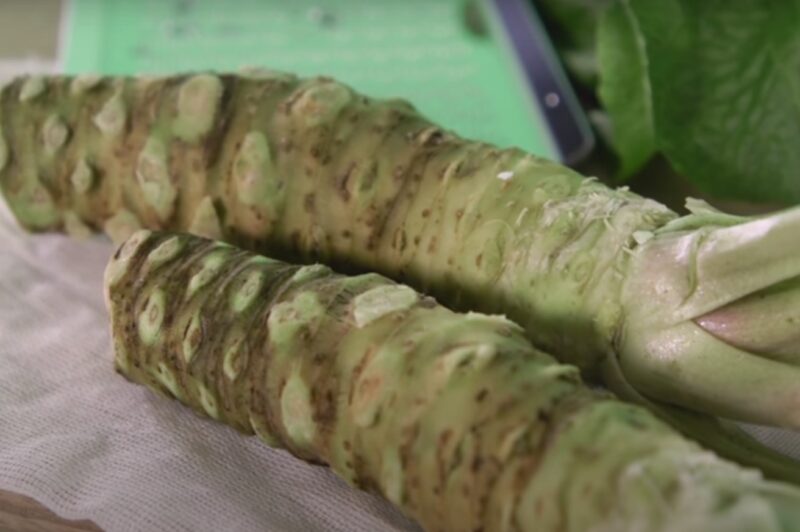You may wonder if wasabi, a green sauce with sushi, is vegan. It is a quite common spice for many dishes. The answer might surprise since it is not straightforward. You will discover more about this in the following sections.
So, Is It Vegan?

The question of whether wasabi is vegan-friendly is more nuanced than a simple yes or no answer. To understand this, it’s crucial to differentiate between real wasabi and the more common wasabi-like products found in stores and restaurants.
Real wasabi, known scientifically as Wasabia japonica, is a plant belonging to the Brassicaceae family, which includes mustards, horseradish, and cabbage. The rare and expensive nature of this plant means that it’s seldom used in everyday cuisine.
True wasabi is naturally vegan, as it’s derived purely from the wasabi plant’s rhizome (a type of root). However, its availability is limited due to its high cost and short shelf life.
Most of the wasabi served in restaurants or sold in stores is not real wasabi but a substitute made primarily from horseradish, mustard, starch, and green coloring. This version is often vegan-friendly, as it typically doesn’t contain any animal-derived ingredients.
The horseradish-based product provides a similar heat and flavor to genuine wasabi, making it a cost-effective and widely accessible alternative. However, there are exceptions.
Some brands, like S&B, produce both real and imitation wasabi products. S&B’s genuine wasabi includes lactose, a milk derivative, which disqualifies it from being vegan.
On the other hand, their imitation wasabi, which uses sorbitol instead of lactose, is vegan. This highlights the importance of reading labels and understanding product compositions for those following a strict vegan diet.
| Feature | Description | Vegan Status |
|---|---|---|
| Real Wasabi (Wasabia japonica) | A rare plant from the Brassicaceae family, used in its pure form. | Naturally Vegan |
| Availability | Rare and expensive, with a short shelf life, leading to limited use in everyday cuisine. | — |
| Common Wasabi Substitutes | Mostly made from horseradish, mustard, starch, and green coloring. | Often Vegan-Friendly |
| Non-Vegan Ingredients | In some brands, like S&B’s real wasabi, lactose (a milk derivative) is included. | Not Vegan |
| Vegan Alternatives | Imitation wasabi products, such as S&B’s version using sorbitol instead of lactose. | Vegan |
| Label Reading | Important for those on a strict vegan diet to understand product compositions. | — |
What are The Non-Vegan Variations?

When exploring the world of wasabi, it’s essential to recognize that not all variations of this condiment are suitable for vegans. Non-vegan variations can arise from the inclusion of specific ingredients that are animal-derived or processed using animal products. Understanding these variations is key for those adhering to a strict vegan diet.
1. Wasabi with Dairy Products
Some brands, particularly those producing real wasabi, include dairy derivatives like lactose. This is common in more authentic wasabi pastes where lactose is used to enhance texture and flavor. For example, the brand S&B, known for producing real wasabi, includes lactose in their product. This makes it unsuitable for vegans.
- Wasabi and Cream Cheese Dip: This dip combines cream cheese with non-vegan wasabi paste, offering a creamy texture with a spicy kick, often served with crackers or vegetables.
2. Wasabi with Gelatin
Though less common, some wasabi products may use gelatin as a stabilizer or thickener. Gelatin is derived from animal collagen and is a common non-vegan ingredient in many food products.
3. Artificial Colors and Preservatives
While not directly animal-derived, some vegans avoid artificial colors and preservatives, which are prevalent in many wasabi substitutes. These ingredients are often tested on animals or have complex supply chains that might not align with strict vegan ethics.
Recipe for the Vegan Wasabi
Creating a vegan version of wasabi at home is simpler than you might think. It ensures you can enjoy the unique, spicy flavor without any animal-derived ingredients.
Ingredients:
Here’s what you’ll need for your vegan wasabi:
- 2 tablespoons of dried, ground horseradish powder
- 1 tablespoon of hot water (adjust as needed for consistency)
- 1/2 teaspoon of spirulina powder (for color)
- 1/2 teaspoon of sugar (optional, for a slight sweetness)
- A pinch of salt
- 1 teaspoon of apple cider vinegar
Instructions:
Follow these steps to create your homemade vegan wasabi:
- Mix Horseradish and Water: In a small bowl, combine the dried horseradish powder with hot water. Start with a tablespoon of water and add more if needed to achieve the desired consistency. The mixture should form a thick paste.
- Add Color and Flavor: Stir in the spirulina powder to give your wasabi its characteristic green color. Spirulina is a natural, plant-based ingredient that works perfectly for this purpose.
- Sweeten (Optional): If you prefer a slightly sweet taste to balance the spiciness, add half a teaspoon of sugar. This step is optional and can be adjusted according to your taste preferences.
- Season: Add a pinch of salt to enhance the flavors. Salt works to bring out the natural zing of horseradish.
- Acidify: Finally, stir in the apple cider vinegar. Vinegar not only adds a tangy taste but also helps preserve the wasabi paste for a little longer.
- Let It Rest: Allow the mixture to sit for about 10 to 15 minutes before serving. This resting time lets the flavors meld together, intensifying the overall taste.
- Storage: Store any leftover vegan wasabi in an airtight container in the refrigerator. It’s best used within a few days for optimal flavor and freshness.
Serving Suggestions:
- Sushi and Sashimi: Pair your vegan wasabi with homemade sushi or sashimi for an authentic Japanese dining experience.
- Noodle Dishes: Add a kick to ramen or other noodle dishes with a small dollop of wasabi.
- Dips and Sauces: Mix your vegan wasabi with soy sauce or vegan mayo to create flavorful dips and sauces.
Health Benefits of Wasabi

It offers several health benefits, making it a valuable addition to your diet. Here’s a look at some of the key benefits of incorporating wasabi into your meals.
Anti-Inflammatory Properties
Wasabi contains compounds called isothiocyanates, which are derived from glucosinolates found in the plant. These compounds have been shown to have anti-inflammatory effects. Chronic inflammation is linked to various health conditions, so incorporating anti-inflammatory foods like wasabi can be beneficial.
Antimicrobial Effects
The natural chemicals in wasabi have antimicrobial properties, making it effective against certain bacteria and fungi. This is particularly beneficial in sushi, as wasabi can help neutralize harmful bacteria found in raw fish.
Cancer-Fighting Potential
Research suggests that the isothiocyanates in wasabi may also help in the fight against cancer. These compounds appear to inhibit the growth of certain cancer cells, although more research is needed to fully understand their potential in cancer therapy.
Respiratory Health

Wasabi’s strong aroma and spicy nature can help clear the sinuses and respiratory passages. This makes it potentially beneficial for those with respiratory ailments, although it should not replace prescribed treatments.
Cardiovascular Health
Wasabi may contribute to heart health. Some studies suggest that the components in wasabi can help reduce the risk of heart disease by improving blood flow and reducing the likelihood of blood clots.
Digestive Health
Wasabi may aid digestion due to its fiber content and the presence of digestive enzymes. Including it in your diet can help maintain a healthy digestive system.
Bone Health

Wasabi is also rich in calcium and potassium, essential minerals for bone health. Regular consumption can contribute to stronger bones and may help prevent conditions like osteoporosis.
Weight Management
Being low in calories and high in fiber, wasabi can be a flavorful addition to a weight management diet. It adds a burst of flavor without adding significant calories.
Are there Potential Side-Effects?
There is a chance for certain downsides when consumed in large amounts. Also, some groups should consider avoiding it, or at least eat in very small amounts.
- Gastrointestinal Issues: Can cause heartburn, nausea, or diarrhea, especially in those with sensitive stomachs or digestive disorders.
- Allergic Reactions: Rare, but can include itching, swelling, or hives, and in severe cases, anaphylaxis.
- Respiratory Effects: Intense fumes may temporarily affect breathing, potentially triggering coughing or shortness of breath.
- Interactions with Medications: Contains vitamin K, which could interact with blood-thinning medications.
FAQs
Why do Japanese like wasabi?
Some possible reasons why Japanese people like wasabi are:
- Wasabi has a unique spicy and refreshing flavor that enhances the taste of raw fish and other dishes.
- Wasabi has antibacterial and anti-inflammatory properties that help prevent food poisoning and infections.
Which sauces are not vegan?
Some examples of sauces that are not vegan are:
- Worcestershire sauce, which contains anchovies (fish) as an ingredient.
- Mayonnaise, which contains eggs and sometimes honey as ingredients.
- Horseradish sauce, which may contain cream, butter, or cheese as ingredients.
Why is soy sauce not vegan?
Soy sauce is not vegan because it contains fermented soybeans, which can be processed with dairy products. The soybeans are soaked and then mashed into a paste. This paste is then combined with other ingredients, such as wheat flour and yeast, and left to ferment for a period of time.
Is sriracha vegan?
Sriracha is usually vegan, as it is made from plant-based ingredients such as chili peppers, vinegar, garlic, sugar, and salt. However, some brands of sriracha may contain non-vegan additives such as fish sauce, honey, or bone char-filtered sugar. Therefore, it is important to check the label before buying or consuming sriracha.
Last Words
The vegan status of wasabi largely depends on its form – real or imitation – and the specific brand. Real wasabi, a rare and expensive plant derivative, is naturally vegan. Most commercially available wasabi, however, is a vegan-friendly horseradish-based substitute.
It’s essential for vegans to check labels, especially for products like S&B’s real wasabi that contain non-vegan ingredients like lactose. If you are a strict vegan diet, you should learn more about other types of food. For example, if you can eat Jack In The Box Tacos.

